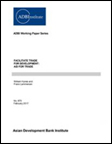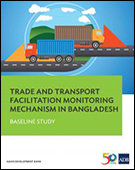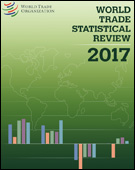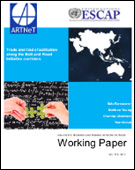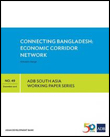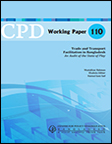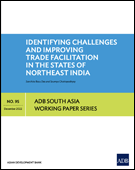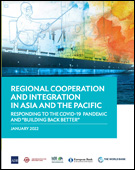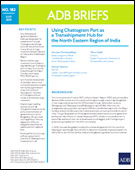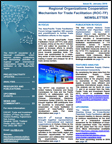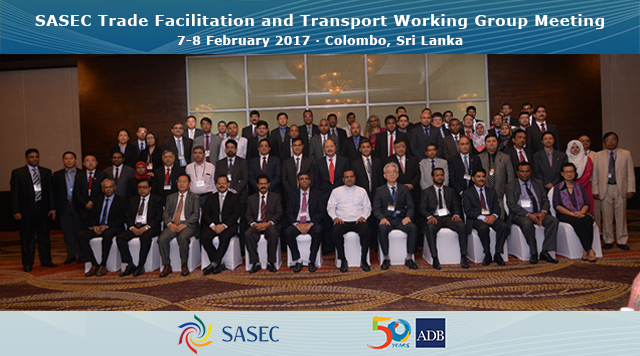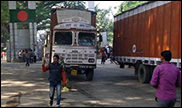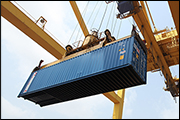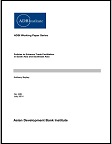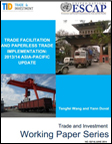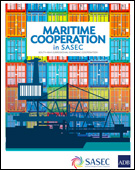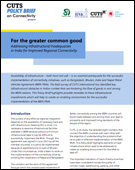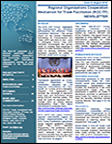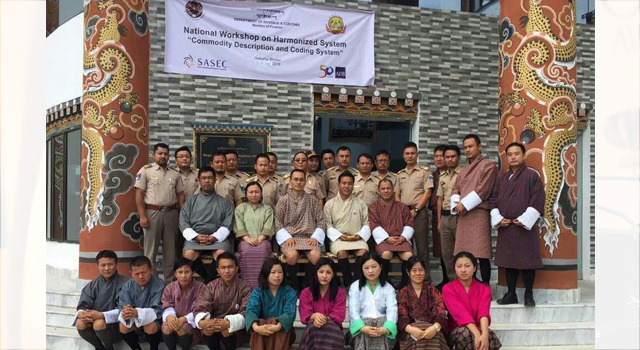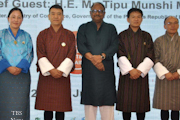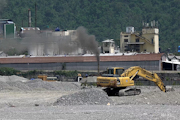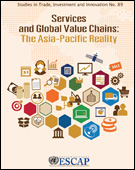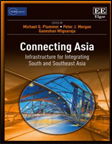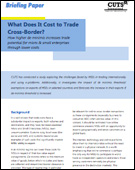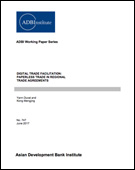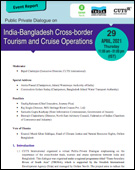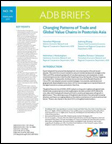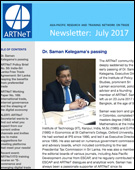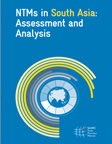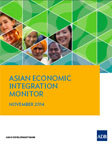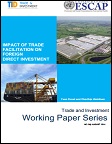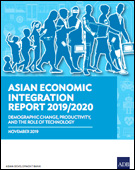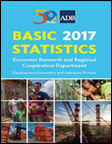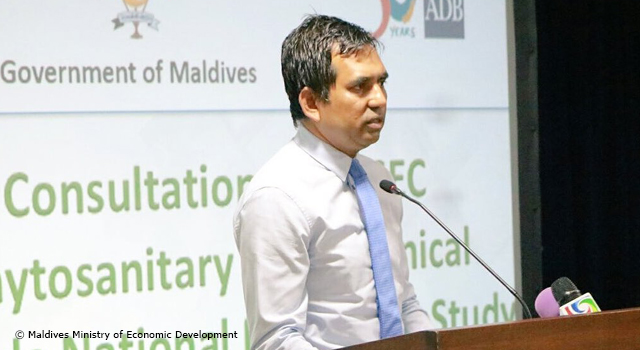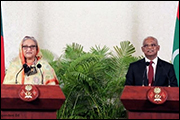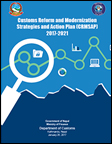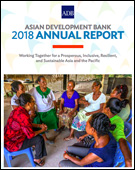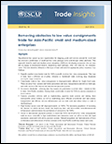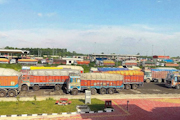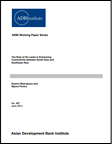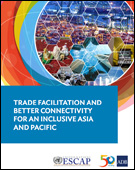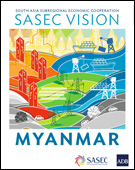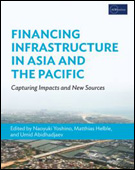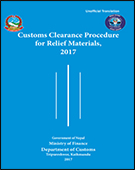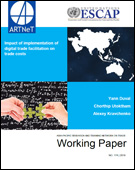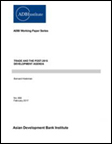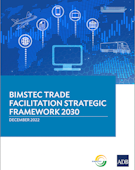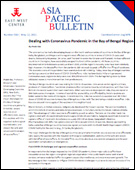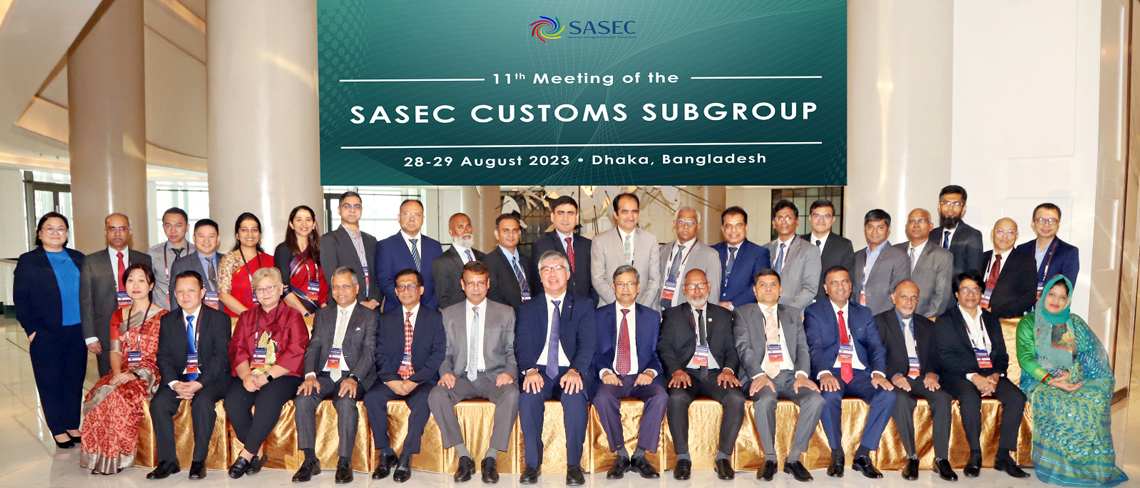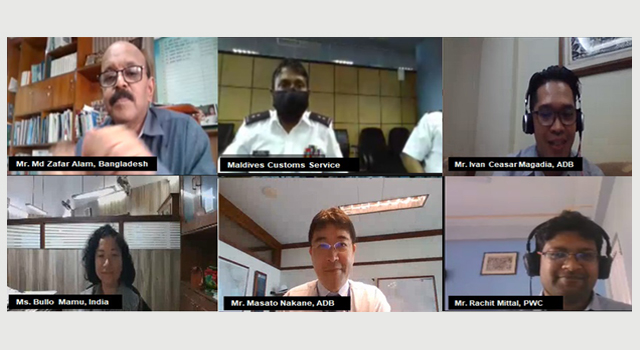Trade Facilitation
Trade facilitation focuses on removing barriers to the international movement of goods and cargo to lower trade costs, at and around the border and along the supply chain, to make countries more competitive in regional and global markets. In the SASEC subregion, bottlenecks in trade facilitation are the leading non-tariff barriers that constrain intraregional trade. SASEC trade facilitation initiatives aim to make cross-border trade and transport in the subregion faster, cheaper, and more predictable, while maintaining the security of the supply chain and ensuring the effectiveness and efficiency of all involved players.
Search by Topic
Suggested Topics
PUBLICATIONS
showing 3 of 17 VIEW ALLThe Aid for Trade program has been providing support to developing economies in tackling obstacles to growth through better facilitation of trade in the last 10 years. Since its launch in 2006, a total of $308 billion has been disbursed to finance aid-for-trade programs and projects, which are working to reduce trade and transport costs, promote trade expansion, and achieve economic and social objectives. As high trade costs persist in keeping developing countries from fully exploiting their trade and development potential, the Aid for Trade program remains highly relevant, and will help developing economies, including landlocked and small and vulnerable economies, achieve the 2030 Agenda for Sustainable Development.
This report synthesizes the business process analysis conducted on the export of plastic kitchenware and tableware from Bangladesh to Bhutan through Burimari land port, and the import of lentils from Nepal to Bangladesh through Banglabandha land port, as well as studies on trade corridors and border crossings in Bangladesh, to quantify current trade and transport facilitation in Bangladesh through a set of indicators. Findings of the study reveal bottlenecks to trade, including costly one-time procedures for a new trader, numerous documents and copies required to complete export and import processes, and low speed along the trade corridors. This report includes specific short-term and long-term policies to improve Bangladesh’s trade and transport facilitation.
Source: Asian Development Bank
The World Trade Statistical Review looks at the last 10 years and examines the latest developments in world trade, with a detailed analysis of the most recent trends for trade in goods and services. The book gives information on the participation of India, Bangladesh, and other South Asian economies in world trade, and highlights trends in the use of trade-facilitating measures. It also gives information on the implementation of the WTO Trade Facilitation Agreement and regional trade agreements, such as the South Asian Free Trade Arrangement.
Source: World Trade Organization
WORKING PAPER
showing 3 of 7 VIEW ALLThis paper reviews the current state of trade and trade facilitation among the countries along the six corridors under the Belt Road Initiative (BRI), and looks at the potential impact of infrastructure development on trade. It explores at the Bangladesh-China-India-Myanmar (BCIM) corridor, and reviews trade growth, tariff rates, logistics performance index, ease of trading across borders, and other indicators in those countries.
Source: Bala Ramasamy, Matthew Yeung, Chorthip Utoktham, and Yann Duval
Economic corridors anchored on transport connectivity could significantly boost Bangladesh's economic growth. This paper presents a new set of corridors for Bangladesh – a nine-corridor comprehensive integrated multimodal economic corridor network that will enhance Bangladesh’s role as land bridge between South Asia and Southeast Asia, and between South Asia and northern Asia. These proposed corridors are designed to sustain robust economic growth over the long term by improving regional connectivity, transit, and integration, alongside trade facilitation measures.
Source: Mohuiddin Alamgir
This publication provides a detailed picture of the status of specific measures for trade and transport facilitation in Bangladesh. It identifies measures already adopted, including strengthening of trade-related institutions, improvements in Customs processes and procedures, and reduction of non-trade barriers, highlighting areas for improvement and identifying existing gaps, to allow for proposals to meet these gaps. The audit undertaken aims to support policy-makers in Bangladesh in mobilizing the financial resources required to build a modern and efficient trade and transport facilitation system.
Source: Mustafizur Rahman, Khaleda Akhter and Naimul Gani Saif
REPORTS
showing 3 of 38 VIEW ALLThe northeast of India is shares international borders with Bangladesh, Bhutan, Nepal, and Myanmar and acts as a bridge for India's participation in global forums through the Bay of Bengal Initiative for Multisectoral Technical and Economic Cooperation and the South Asia Subregional Economic Cooperation program. This paper highlights challenges in global trade and suggests ways for improving trade with other countries in South Asia and Southeast Asia.
Platforms for regional and subregional cooperation helped spur collective action to help Asia and the Pacific build back resiliency from the coronavirus disease (COVID-19) pandemic. Regional cooperation platforms such as the South Asia Subregional Economic Cooperation program helped countries respond to the COVID-19 emergency. In South Asia, partners will have the opportunities to support regional market development through transport corridors, trade facilitation, and cross-border energy trade post-COVID-19.
Source: Asian Development Bank
The brief focuses on developing logistics in India's northeastern region and Bangladesh. To facilitate seamless transshipment movement through Chattogram port, this brief presents a framework to promote sustainable development and suggests ways to address infrastructure and regulatory gaps.
This biannual publication features updates, publications and forthcoming activities of regional and international organizations working on trade facilitation in the Asia-Pacific region, including the Asian Development Bank (ADB), the World Customs Organization (WCO), and the United Nations Economic and Social Commission for Asia and the Pacific. It includes highlights of the Asia Pacific Trade Facilitation Forum 2015 and the Train-the-Trainer Workshops on Customs Valuation through Post Clearance Audit being jointly implemented by the WCO and ADB in the 6 SASEC member countries. This issue also features an analysis on achieving seamless supply chains through implementing comprehensive and pragmatic national trade facilitation reform programs.
Source: UNESCAP
EVENT MATERIALS
showing 3 of 34 VIEW ALL2017-11-21, Dhaka, Bangladesh
2017-02-07, Colombo, Sri Lanka
2016-11-21, Dhaka, Bangladesh
NEWS & MULTIMEDIA
showing 3 of 119 VIEW ALLThe National Board of Revenue (NBR) of the Government of Bangladesh is set to open the first phase of its National Single Window (NSW) services to expedite export-import trade. NBR plans to roll out the Users Acceptance Test of select certificate-licensing and permit-issuing agencies for NSW in January 2024.
Pristine Logistics & Infraprojects of India, a rail terminal operator, has entered a joint venture with Summit Alliance Port of Bangladesh, which handles over 25% of export cargo and 15% of import cargo of Bangladesh’s containerized volume.
Regular cargo movement from India’s northeastern region to the Syama Prasad Mookerjee Port (SMP) in Kolkata through Bangladesh is set to commence soon.
PUBLICATIONS
showing 3 of 10 VIEW ALLThe World Trade Statistical Review looks at the last 10 years and examines the latest developments in world trade, with a detailed analysis of the most recent trends for trade in goods and services. The book gives information on the participation of India, Bangladesh, and other South Asian economies in world trade, and highlights trends in the use of trade-facilitating measures. It also gives information on the implementation of the WTO Trade Facilitation Agreement and regional trade agreements, such as the South Asian Free Trade Arrangement.
Source: World Trade Organization
This report synthesizes the business process analysis conducted on the export of plastic kitchenware and tableware from Bangladesh to Bhutan through Burimari land port, and the import of lentils from Nepal to Bangladesh through Banglabandha land port, as well as studies on trade corridors and border crossings in Bangladesh, to quantify current trade and transport facilitation in Bangladesh through a set of indicators. Findings of the study reveal bottlenecks to trade, including costly one-time procedures for a new trader, numerous documents and copies required to complete export and import processes, and low speed along the trade corridors. This report includes specific short-term and long-term policies to improve Bangladesh’s trade and transport facilitation.
Source: Asian Development Bank
The Aid for Trade program has been providing support to developing economies in tackling obstacles to growth through better facilitation of trade in the last 10 years. Since its launch in 2006, a total of $308 billion has been disbursed to finance aid-for-trade programs and projects, which are working to reduce trade and transport costs, promote trade expansion, and achieve economic and social objectives. As high trade costs persist in keeping developing countries from fully exploiting their trade and development potential, the Aid for Trade program remains highly relevant, and will help developing economies, including landlocked and small and vulnerable economies, achieve the 2030 Agenda for Sustainable Development.
This Asian Development Bank Institute publication identifies the state of play of trade facilitation and provides an overview of intra- and inter-regional trade in South and Southeast Asia. It highlights key challenges and bottlenecks to effective trade facilitation, ranging from the lack of expert human resources such as information technology specialists in small landlocked countries (Bhutan and Nepal), to the high border transaction costs and severe congestion faced at border crossing points, and the lack of effective dialogue on bilateral enhancement of trade facilitation. Regional initiatives such as the South Asia Subregional Economic Cooperation Program aim to address these challenges through customs modernization and harmonization, automation, and the use of international best practices in border procedures.
Source: Anthony Bayley
This paper reports survey findings on progress in implementing various trade facilitation and paperless trade measures made by 29 countries in Asia and the Pacific, including six SASEC member countries. Factors considered include pre-arrival clearance, post-clearance audit, National Single Window, and authorized operator programmes. The survey reveals that while countries have prioritized automation and paperless trade at the regional level, there is an urgent need for regional arrangements that will facilitate cross-border exchange of trade-related electronic documents and information to enable smoother trade facilitation.
Source: Tengfei Wang and Yann Duval
REPORTS
showing 3 of 29 VIEW ALLThe northeast of India is shares international borders with Bangladesh, Bhutan, Nepal, and Myanmar and acts as a bridge for India's participation in global forums through the Bay of Bengal Initiative for Multisectoral Technical and Economic Cooperation and the South Asia Subregional Economic Cooperation program. This paper highlights challenges in global trade and suggests ways for improving trade with other countries in South Asia and Southeast Asia.
Most South Asia Subregional Economic Cooperation (SASEC) countries rely on maritime transport for international trade. Stronger maritime relations are crucial to achieve the economic growth potential for the subregion. This report looks at how countries can strengthen international trade by improving maritime cooperation among the SASEC countries, comprised of Bangladesh, Bhutan, India, Maldives, Myanmar, Nepal, and Sri Lanka. It gives an overview of the SASEC maritime sector and identifies collaboration initiatives that could address key challenges.
Source: Asian Development Bank
Both soft and hard infrastructure are needed to successfully implement the Bangladesh, Bhutan, India, and Nepal Motor Vehicles Agreement (BBIN MVA) and other connectivity initiatives. This field survey report identifies infrastructural gaps in India and suggests possible remedies to help improve flow of goods among the BBIN economies.
Source: CUTS International
This biannual publication features updates, publications and forthcoming activities of regional and international organizations working on trade facilitation in the Asia-Pacific region, including the Asian Development Bank (ADB), the World Customs Organization (WCO), and the United Nations Economic and Social Commission for Asia and the Pacific. It includes highlights of the Asia Pacific Trade Facilitation Forum 2015 and the Train-the-Trainer Workshops on Customs Valuation through Post Clearance Audit being jointly implemented by the WCO and ADB in the 6 SASEC member countries. This issue also features an analysis on achieving seamless supply chains through implementing comprehensive and pragmatic national trade facilitation reform programs.
Source: UNESCAP
This issue highlights the framework agreement on cross-border paperless trade facilitation adopted by the United Nations Regional Commission for Asia-Pacific, which will facilitate the exchange of electronic trade data and documents between participating United Nations Economic and Social Commission for Asia and the Pacific (UNESCAP) member states, and the 2016 Global Facilitation Partnership for Transportation and Trade forum. The latterencourages the private sector to mobilize expertise in support of trade facilitation reforms to develop effective trade facilitation solutions for small and medium-sized enterprises. The Newsletter also features SASEC-supported initiatives, including the launch of the new Maldives Customs Service training module on Customs valuation, as well as data collection for establishing the Trade and Transport Facilitation Monitoring baseline in Bhutan. The ROC-TF newsletter is a biannual publication featuring updates, publications and forthcoming activities of regional and international organizations working on trade facilitation in the Asia-Pacific region, including the Asian Development Bank, the World Customs Organization, and UNESCAP.
Source: United Nations Economic and Social Commission for Asia and the Pacific
EVENT MATERIALS
showing 3 of 45 VIEW ALL2022-01-03, Punakha, Bhutan
2017-02-07, Colombo, Sri Lanka
2016-08-22, Gelephu, Bhutan
NEWS & MULTIMEDIA
showing 3 of 65 VIEW ALLBhutan will build the Gelephu Smart City Project in the Gelephu Special Administrative Region to facilitate more foreign investment for the country.
Mr. Tipu Munshi, Commerce Minister of the Government of Bangladesh, invited Bhutan to build an economic zone in Bangladesh to boost the trade relationship between the two countries. He also encouraged businesses from Bangladesh and Bhutan to lead the trade expansion by establishing strong relationships with each other to reap the benefits of their preferential trade and transit agreements.
Construction of the mega dry port at Pasakha, Phuentsholing, is on track, amid challenges faced during the COVID-19 pandemic. Work on the dry port began in 2020 and has achieved almost 45% completion. The aim is to complete the dry port by mid-2026.
PUBLICATIONS
showing 3 of 22 VIEW ALLThis book reviews issues concerning the roles of services in global value chains. It presents a framework for assessing links among different services and between services and the manufacturing sector. The book explains the contribution of services to global value chains in the Asia-Pacific region and to the world and also draws lessons with which countries could understand the importance of services and participation in global value chains to achieving sustainable development.
The World Trade Statistical Review looks at the last 10 years and examines the latest developments in world trade, with a detailed analysis of the most recent trends for trade in goods and services. The book gives information on the participation of India, Bangladesh, and other South Asian economies in world trade, and highlights trends in the use of trade-facilitating measures. It also gives information on the implementation of the WTO Trade Facilitation Agreement and regional trade agreements, such as the South Asian Free Trade Arrangement.
Source: World Trade Organization
This book contains background papers prepared for the Asian Development Bank and the Asian Development Bank Institute joint study, 'Connecting South Asia and Southeast Asia.' It emphasizes the potential contribution to growth that greater connectivity—through better transport and energy infrastructure and improved soft infrastructure, including trade facilitation—between South Asia and Southeast Asia can foster. With benefits including greater participation in global supply chains for South Asia; lower trade costs; and increase in inter- and intraregional trade, the book underscores that, at a juncture where closer regional integration can secure sustainable and inclusive growth for economies in the two regions, specific policies should be examined and considered to enable both regions to maximize gains from greater integration.
Source: Michael G. Plummer, Peter J. Morgan, Ganeshan Wignaraja, eds.
WORKING PAPER
showing 3 of 10 VIEW ALLCustoms duties, local taxes, and customs clearance increase trade costs and serve as obstacles for many small and medium enterprises. This paper explores challenges these enterprises face in using e-platforms and trading internationally. It looks at de minimis exemptions (the minimum value of goods below which no duties are collected) in India and other economies and analyzes the impact of these exemptions on exports by micro and small enterprises.
Source: Sanjay Kumar Mangla
Most regional trade agreements now feature one or more measures for electronically exchanging trade-related information. These measures are becoming essential to maintaining trade competitiveness and enabling effective participation in cross-border e-commerce. This paper examines the extent to which measures enabling paperless trade are included in regional trade agreements (RTAs), such as the Association of Southeast Asian Nations-India Free Trade Agreement. India leads the region with the highest number of RTAs involving paperless trade measures. Asia-Pacific RTAs now increasingly cover specific areas of paperless trade such as electronic certificates of origin and sanitary and phytosanitary certificates.
Source: Yann Duval and Kong Mengjing
This paper reviews the current state of trade and trade facilitation among the countries along the six corridors under the Belt Road Initiative (BRI), and looks at the potential impact of infrastructure development on trade. It explores at the Bangladesh-China-India-Myanmar (BCIM) corridor, and reviews trade growth, tariff rates, logistics performance index, ease of trading across borders, and other indicators in those countries.
Source: Bala Ramasamy, Matthew Yeung, Chorthip Utoktham, and Yann Duval
REPORTS
showing 3 of 37 VIEW ALLThe northeast of India is shares international borders with Bangladesh, Bhutan, Nepal, and Myanmar and acts as a bridge for India's participation in global forums through the Bay of Bengal Initiative for Multisectoral Technical and Economic Cooperation and the South Asia Subregional Economic Cooperation program. This paper highlights challenges in global trade and suggests ways for improving trade with other countries in South Asia and Southeast Asia.
Platforms for regional and subregional cooperation helped spur collective action to help Asia and the Pacific build back resiliency from the coronavirus disease (COVID-19) pandemic. Regional cooperation platforms such as the South Asia Subregional Economic Cooperation program helped countries respond to the COVID-19 emergency. In South Asia, partners will have the opportunities to support regional market development through transport corridors, trade facilitation, and cross-border energy trade post-COVID-19.
Source: Asian Development Bank
Trade and tourism along transboundary rivers bring socioeconomic opportunities in India and Bangladesh. This report for the webinar "Public Private Dialogue on India-Bangladesh Cross-border Tourism and Cruise Operations" suggests that easing security, customs, and immigration protocols while strengthening safety measures would help ensure that cruise operations are inclusive and sustainable.
Source: CUTS International
PERIODICALS
showing 3 of 4 VIEW ALLThis Asian Development Bank brief examines how patterns of trade and global value chains (GVCs) in developing Asia have changed since the global financial crisis. The paper reports that export slowdown in the region was caused by a combination of weak import demand for Asian goods in advanced economy markets, structural transformation and reduced import demand in the People’s Republic of China, and possible impact of increasing non-tariff measures. According to this paper, it further states that much of the weak import demand is likely to be temporary — developing Asia gained a 1.5% increase in exports in 2016, after a 0.8% decline in 2015. Among South Asian economies, India and Sri Lanka are expected to have better export volume growth in 2016.
Source: Ganeshan Wignaraja, Juzhong Zhuang, Mahinthan J. Mariasingham, and Madeline Dumaua-Cabauatan
Asia-Pacific Research and Training Network on Trade (ARTNeT) is an open regional network composed of leading trade research institutions and think tanks across the Asia-Pacific region. The 2017 July issue of its newsletter features the benefits Sri Lanka could reap from its free trade agreement with India and the shaping of the digital trade agenda.
This biannual publication features updates, publications and forthcoming activities of regional and international organizations working on trade facilitation in the Asia-Pacific region, including the Asian Development Bank (ADB), the World Customs Organization (WCO), and the United Nations Economic and Social Commission for Asia and the Pacific. It includes highlights of the Asia Pacific Trade Facilitation Forum 2015 and the Train-the-Trainer Workshops on Customs Valuation through Post Clearance Audit being jointly implemented by the WCO and ADB in the 6 SASEC member countries. This issue also features an analysis on achieving seamless supply chains through implementing comprehensive and pragmatic national trade facilitation reform programs.
Source: UNESCAP
EVENT MATERIALS
showing 3 of 37 VIEW ALL2017-03-06, Kathmandu, Nepal
2017-02-07, Colombo, Sri Lanka
2016-11-10, Delhi, India
NEWS & MULTIMEDIA
showing 3 of 148 VIEW ALLBhutan will build the Gelephu Smart City Project in the Gelephu Special Administrative Region to facilitate more foreign investment for the country.
Pristine Logistics & Infraprojects of India, a rail terminal operator, has entered a joint venture with Summit Alliance Port of Bangladesh, which handles over 25% of export cargo and 15% of import cargo of Bangladesh’s containerized volume.
Regular cargo movement from India’s northeastern region to the Syama Prasad Mookerjee Port (SMP) in Kolkata through Bangladesh is set to commence soon.
PUBLICATIONS
showing 3 of 7 VIEW ALLThe World Trade Statistical Review looks at the last 10 years and examines the latest developments in world trade, with a detailed analysis of the most recent trends for trade in goods and services. The book gives information on the participation of India, Bangladesh, and other South Asian economies in world trade, and highlights trends in the use of trade-facilitating measures. It also gives information on the implementation of the WTO Trade Facilitation Agreement and regional trade agreements, such as the South Asian Free Trade Arrangement.
Source: World Trade Organization
The study “NTMs in South Asia: Assessment and Analysis” analyzes how Non-tariff Measures (NTMs) give rise to non-tariff barriers, which are becoming increasingly crucial for advancing trade cooperation among member countries of the South Asian Association for Regional Cooperation, yet remain less-addressed. The study examines export potential and actual export of South Asian countries, and attempts to highlight gains from reduction in transaction costs in bilateral trade. It also notes that initiatives for trade facilitation reforms in South Asia at the regional level remain low in incentives and have yet to produce significant results. The study closes with several recommendations for reducing and eliminating NTMs.
Source: Selim Raihan, Mostafa Abid Khan, and Shaquib Quoreshi
This AEIM review of recent economic performance highlights the need for Asia to rebalance its sources of growth toward domestic and regional demand. It also shows a resilient Asia with rising GDP growth in South Asia. This issue includes a Special Chapter: Regional Financial Integration and Crisis in Asia and Europe – A Comparative Analysis. It presents Asia’s future path of integration as different from that in Europe. Asia will continue to strengthen efforts to harmonize rules and regulations in the financial sector and further unilateral trade and investment, while Europe is more likely to strengthen regional institutions to ensure recovery and better the monetary union.
Source: Asian Development Bank
This United Nations Economic and Social Commission for Asia and the Pacific Trade and Investment Working Paper attempts to quantify the potential impact of trade facilitation on foreign direct investment (FDI) flows. The study uses bilateral FDI data from 2006 onward from both developing and developed countries, including South-South FDI flows, wherein contiguity (common border between source and host country) and geographic distance are found to be much more important factors. In applying an augmented FDI model framework to determine the effect of comprehensive international trade costs, the results show that both non-tariff and tariff costs are important determinants of FDI inflows.
Source: Yann Duval and Chorthip Utoktham
This paper reports survey findings on progress in implementing various trade facilitation and paperless trade measures made by 29 countries in Asia and the Pacific, including six SASEC member countries. Factors considered include pre-arrival clearance, post-clearance audit, National Single Window, and authorized operator programmes. The survey reveals that while countries have prioritized automation and paperless trade at the regional level, there is an urgent need for regional arrangements that will facilitate cross-border exchange of trade-related electronic documents and information to enable smoother trade facilitation.
Source: Tengfei Wang and Yann Duval
REPORTS
showing 3 of 17 VIEW ALLThis report reviews economic cooperation and integration in Asia and the Pacific. It reports that in 2018, the South Asia Subregional Economic Cooperation (SASEC) focused on reducing gaps in multimodal connectivity among its member countries. By the end of 2018, 52 ADB-financed projects worth $11.36 billion had been committed to SASEC projects, with an additional $106.44 million in 81 technical assistance grants. SASEC nodal officials and working groups met in Singapore in March 2018 to update the SASEC operational plan. The operational plan identified 77 projects ($45.6 billion) to be financed by SASEC members, ADB, and development partners. A holistic approach under the operational plan will build transport links with Southeast Asia and East Asia and expand regional trade markets.
Source: Asian Development Bank
Most South Asia Subregional Economic Cooperation (SASEC) countries rely on maritime transport for international trade. Stronger maritime relations are crucial to achieve the economic growth potential for the subregion. This report looks at how countries can strengthen international trade by improving maritime cooperation among the SASEC countries, comprised of Bangladesh, Bhutan, India, Maldives, Myanmar, Nepal, and Sri Lanka. It gives an overview of the SASEC maritime sector and identifies collaboration initiatives that could address key challenges.
Source: Asian Development Bank
Basic Statistics 2017 contains development indicators for 45 economies in the Asia and Pacific Region, including the seven SASEC countries, Bangladesh, Bhutan, India, Maldives, Myanmar, Nepal, and Sri Lanka. It includes selected indicators of the Sustainable Development Goals (SDGs) such as the proportion of population living below $1.90 (PPP) a day, proportion of population with access to electricity, renewable energy share in the total final energy consumption, unemployment rate, total official flows for infrastructure, and trade balance.
Source: Asian Development Bank
This issue highlights the framework agreement on cross-border paperless trade facilitation adopted by the United Nations Regional Commission for Asia-Pacific, which will facilitate the exchange of electronic trade data and documents between participating United Nations Economic and Social Commission for Asia and the Pacific (UNESCAP) member states, and the 2016 Global Facilitation Partnership for Transportation and Trade forum. The latterencourages the private sector to mobilize expertise in support of trade facilitation reforms to develop effective trade facilitation solutions for small and medium-sized enterprises. The Newsletter also features SASEC-supported initiatives, including the launch of the new Maldives Customs Service training module on Customs valuation, as well as data collection for establishing the Trade and Transport Facilitation Monitoring baseline in Bhutan. The ROC-TF newsletter is a biannual publication featuring updates, publications and forthcoming activities of regional and international organizations working on trade facilitation in the Asia-Pacific region, including the Asian Development Bank, the World Customs Organization, and UNESCAP.
Source: United Nations Economic and Social Commission for Asia and the Pacific
This biannual publication features updates, publications and forthcoming activities of regional and international organizations working on trade facilitation in the Asia-Pacific region, including the Asian Development Bank (ADB), the World Customs Organization (WCO), and the United Nations Economic and Social Commission for Asia and the Pacific. It includes highlights of the Asia Pacific Trade Facilitation Forum 2015 and the Train-the-Trainer Workshops on Customs Valuation through Post Clearance Audit being jointly implemented by the WCO and ADB in the 6 SASEC member countries. This issue also features an analysis on achieving seamless supply chains through implementing comprehensive and pragmatic national trade facilitation reform programs.
Source: UNESCAP
EVENT MATERIALS
showing 3 of 13 VIEW ALL2017-02-09, Colombo, Sri Lanka
2017-02-07, Colombo, Sri Lanka
NEWS & MULTIMEDIA
showing 3 of 16 VIEW ALLBangladesh Prime Minister Sheikh Hasina and Maldives President Ibrahim Mohamed Solih held bilateral talks on 23 December 2021 at the President’s Office in Malé, Maldives. They discussed matters of mutual interest and emphasized the importance of signing a Preferential Trade Agreement.
Bangladesh is looking to produce resort wear and leisure apparel for Maldives. Mr. Faruque Hassan, President of BGMEA discussed the potential of tapping this Maldives market with Mr. Shiruzimath Sameer, Bangladesh High Commissioner to Maldives.
The Government of Maldives has signed a $10 million project with the Asian Development Bank (ADB) for its National Single Window Project. The agreement was signed at the sidelines of the Maldives Partnership Forum by Finance Minister Ibrahim Ameer and Mr. Ronald Butiong, Director for Regional Cooperation and Operations Coordination, South Asia Department, ADB.
PUBLICATIONS
showing 3 of 17 VIEW ALLThis book reviews issues concerning the roles of services in global value chains. It presents a framework for assessing links among different services and between services and the manufacturing sector. The book explains the contribution of services to global value chains in the Asia-Pacific region and to the world and also draws lessons with which countries could understand the importance of services and participation in global value chains to achieving sustainable development.
The Customs Reform and Modernization Strategies and Action Plan 2017-2021 of the Nepal Department of Customs (DOC) aims to serve as a blueprint of Customs reform for the next four years, with a vision to support Nepal's initiatives toward economic and social prosperity. With Nepal seeing continuous increase of cross-border trade over the last decades, this Plan is being implemented to align Nepal toward international standards. It outlines the DOC's vision, mission, guiding principles, as well as strategies, such as expediting legitimate trade facilitation and enhancing Customs automation and data management, to create a conducive environment for seamless movement of cargo traffic to and from the borders, and help in lowering transaction costs through greater transport facilitation.
Source: Nepal Department of Customs
This report synthesizes the business process analysis conducted on the export of plastic kitchenware and tableware from Bangladesh to Bhutan through Burimari land port, and the import of lentils from Nepal to Bangladesh through Banglabandha land port, as well as studies on trade corridors and border crossings in Bangladesh, to quantify current trade and transport facilitation in Bangladesh through a set of indicators. Findings of the study reveal bottlenecks to trade, including costly one-time procedures for a new trader, numerous documents and copies required to complete export and import processes, and low speed along the trade corridors. This report includes specific short-term and long-term policies to improve Bangladesh’s trade and transport facilitation.
Source: Asian Development Bank
This Asian Development Bank Institute publication identifies the state of play of trade facilitation and provides an overview of intra- and inter-regional trade in South and Southeast Asia. It highlights key challenges and bottlenecks to effective trade facilitation, ranging from the lack of expert human resources such as information technology specialists in small landlocked countries (Bhutan and Nepal), to the high border transaction costs and severe congestion faced at border crossing points, and the lack of effective dialogue on bilateral enhancement of trade facilitation. Regional initiatives such as the South Asia Subregional Economic Cooperation Program aim to address these challenges through customs modernization and harmonization, automation, and the use of international best practices in border procedures.
Source: Anthony Bayley
This paper reports survey findings on progress in implementing various trade facilitation and paperless trade measures made by 29 countries in Asia and the Pacific, including six SASEC member countries. Factors considered include pre-arrival clearance, post-clearance audit, National Single Window, and authorized operator programmes. The survey reveals that while countries have prioritized automation and paperless trade at the regional level, there is an urgent need for regional arrangements that will facilitate cross-border exchange of trade-related electronic documents and information to enable smoother trade facilitation.
Source: Tengfei Wang and Yann Duval
REPORTS
showing 3 of 29 VIEW ALLThe northeast of India is shares international borders with Bangladesh, Bhutan, Nepal, and Myanmar and acts as a bridge for India's participation in global forums through the Bay of Bengal Initiative for Multisectoral Technical and Economic Cooperation and the South Asia Subregional Economic Cooperation program. This paper highlights challenges in global trade and suggests ways for improving trade with other countries in South Asia and Southeast Asia.
The Asian Development Bank (ADB) supports cross-border infrastructure to help foster regional cooperation and integration. It is transforming transport corridors into economic corridors, allowing South Asian countries to participate in regional and global value chains and promote agriculture trade. In 2018, ADB committed $150 million to upgrade sections of South Asia Subregional Economic Cooperation (SASEC) road corridors in India and Nepal. The investments aim to improve connectivity between Manipur (in India) and Myanmar; build an India–Nepal international bridge; and improve the safety of Nepal’s East–West Highway. ADB also approved a technical assistance project to build institutional capacity and improve expertise of trade facilitation officials in SASEC member countries.
Source: Asian Development Bank
Most South Asia Subregional Economic Cooperation (SASEC) countries rely on maritime transport for international trade. Stronger maritime relations are crucial to achieve the economic growth potential for the subregion. This report looks at how countries can strengthen international trade by improving maritime cooperation among the SASEC countries, comprised of Bangladesh, Bhutan, India, Maldives, Myanmar, Nepal, and Sri Lanka. It gives an overview of the SASEC maritime sector and identifies collaboration initiatives that could address key challenges.
Source: Asian Development Bank
Diffusion of digital technology and digitalization of products and services are allowing developing country small and medium-sized enterprises (SMEs)—which generate the majority of employment, especially in landlocked developing countries such as Nepal—to become globally competitive and participate in international trade. However, several barriers continue to hinder developing country SMEs to maximize benefits of cross-border digital trade. This publication recommends critical actions, including raising de-minimis thresholds; reducing Customs document requirements; developing low-cost and efficient transportation, delivery services, telecommunications and broadband networks; and establishing a legal framework that enhances conduct of online transactions. Additionally, neighbors in the region must coordinate and work together to build the required infrastructure, and to allow for mutual recognition or harmonization of systems, procedures, enforcement mechanisms and laws affecting digital trade.
Source: Pascale Bourquin and Adam Heal
This biannual publication features updates, publications and forthcoming activities of regional and international organizations working on trade facilitation in the Asia-Pacific region, including the Asian Development Bank (ADB), the World Customs Organization (WCO), and the United Nations Economic and Social Commission for Asia and the Pacific. It includes highlights of the Asia Pacific Trade Facilitation Forum 2015 and the Train-the-Trainer Workshops on Customs Valuation through Post Clearance Audit being jointly implemented by the WCO and ADB in the 6 SASEC member countries. This issue also features an analysis on achieving seamless supply chains through implementing comprehensive and pragmatic national trade facilitation reform programs.
Source: UNESCAP
EVENT MATERIALS
showing 3 of 40 VIEW ALL2017-03-06, Kathmandu, Nepal
2017-02-07, Colombo, Sri Lanka
2016-12-30, Birgunj, Nepal
NEWS & MULTIMEDIA
showing 3 of 80 VIEW ALLThe new Nepal Trade Integration Strategy (NTIS) 2023 expands the list of promising export products and services from Nepal to 32, from 12 in the NTIS 2016. Implemented in July, the new products in the latest trade strategy include electricity in the service export category. NTIS 2023 aims to increase the country’s trade-to-GDP ratio to 55% by 2026.
ADB approved a project loan to support continuing reforms in Nepal customs. The financing assistance worth $50 million will enhance policy reforms in customs and logistics to help boost the country’s domestic and international trade. The program will help implement the Government of Nepal’s Customs Reform and Modernization Plan 2021-2026 and improve the country's trade logistics through the preparation and implementation of a new Trade Logistics Policy 2022.
Bangladesh has opened its Banglabandha Land Port for the import of acrylic yarn from Nepal, ending a 17-year-long restriction. A statutory regulatory order was issued by Bangladesh's National Board of Revenue on the matter.
PUBLICATIONS
showing 3 of 16 VIEW ALLThis book reviews issues concerning the roles of services in global value chains. It presents a framework for assessing links among different services and between services and the manufacturing sector. The book explains the contribution of services to global value chains in the Asia-Pacific region and to the world and also draws lessons with which countries could understand the importance of services and participation in global value chains to achieving sustainable development.
The World Trade Statistical Review looks at the last 10 years and examines the latest developments in world trade, with a detailed analysis of the most recent trends for trade in goods and services. The book gives information on the participation of India, Bangladesh, and other South Asian economies in world trade, and highlights trends in the use of trade-facilitating measures. It also gives information on the implementation of the WTO Trade Facilitation Agreement and regional trade agreements, such as the South Asian Free Trade Arrangement.
Source: World Trade Organization
This book contains background papers prepared for the Asian Development Bank and the Asian Development Bank Institute joint study, 'Connecting South Asia and Southeast Asia.' It emphasizes the potential contribution to growth that greater connectivity—through better transport and energy infrastructure and improved soft infrastructure, including trade facilitation—between South Asia and Southeast Asia can foster. With benefits including greater participation in global supply chains for South Asia; lower trade costs; and increase in inter- and intraregional trade, the book underscores that, at a juncture where closer regional integration can secure sustainable and inclusive growth for economies in the two regions, specific policies should be examined and considered to enable both regions to maximize gains from greater integration.
Source: Michael G. Plummer, Peter J. Morgan, Ganeshan Wignaraja, eds.
As Sri Lanka rebuilds at the end of a 30-year conflict, its progress in improving physical infrastructure—including the Colombo port expansion and other programs for new expressways and road connectivity—has been significant. Yet, the country has seen a sharp decline in its overall exports-to-gross domestic product ratio. How Sri Lanka can benefit from greater connectivity with its neighbors in South Asia and Southeast Asia is discussed in this paper. Trade policies geared towards enhancing regional integration efforts could boost Sri Lanka's economy. Additionally, to lessen the challenges of financing and sustaining implementation of planned infrastructure development efforts, Sri Lanka could also implement a more stringent institutional and regulatory environment encouraging more private sector participation.
This paper reports survey findings on progress in implementing various trade facilitation and paperless trade measures made by 29 countries in Asia and the Pacific, including six SASEC member countries. Factors considered include pre-arrival clearance, post-clearance audit, National Single Window, and authorized operator programmes. The survey reveals that while countries have prioritized automation and paperless trade at the regional level, there is an urgent need for regional arrangements that will facilitate cross-border exchange of trade-related electronic documents and information to enable smoother trade facilitation.
Source: Tengfei Wang and Yann Duval
REPORTS
showing 3 of 19 VIEW ALLMost South Asia Subregional Economic Cooperation (SASEC) countries rely on maritime transport for international trade. Stronger maritime relations are crucial to achieve the economic growth potential for the subregion. This report looks at how countries can strengthen international trade by improving maritime cooperation among the SASEC countries, comprised of Bangladesh, Bhutan, India, Maldives, Myanmar, Nepal, and Sri Lanka. It gives an overview of the SASEC maritime sector and identifies collaboration initiatives that could address key challenges.
Source: Asian Development Bank
This report reviews economic cooperation and integration in Asia and the Pacific. It reports that in 2018, the South Asia Subregional Economic Cooperation (SASEC) focused on reducing gaps in multimodal connectivity among its member countries. By the end of 2018, 52 ADB-financed projects worth $11.36 billion had been committed to SASEC projects, with an additional $106.44 million in 81 technical assistance grants. SASEC nodal officials and working groups met in Singapore in March 2018 to update the SASEC operational plan. The operational plan identified 77 projects ($45.6 billion) to be financed by SASEC members, ADB, and development partners. A holistic approach under the operational plan will build transport links with Southeast Asia and East Asia and expand regional trade markets.
Source: Asian Development Bank
This report investigates the evolution of trade costs, examines trade facilitation and paperless trade implementation, and highlights key initiatives in South Asia, including efforts by members of the South Asia Subregional Economic Cooperation (SASEC). The SASEC Trade Facilitation and Transport Working Group agreed to expand assistance to trade facilitation through technical assistance to support more efficient, transparent, secure, and service-oriented processing of cross-border trade across South Asia. Through 2025, the SASEC connectivity agenda will be better aligned with the frameworks of South Asian Association for Regional Cooperation and the Bengal Initiative for Multi-Sectoral Technical and Economic Cooperation. To help establish a trade and transport facilitation monitoring mechanism, Bangladesh, Bhutan, and Nepal conducted studies that reviewed trade and transport procedures, analyzed bottlenecks, and gave recommendations on trade and transport facilitation.
Source: Asian Development Bank and United Nations Economic and Social Commission for Asia and the Pacific
This Asian Development Bank brief examines how patterns of trade and global value chains (GVCs) in developing Asia have changed since the global financial crisis. The paper reports that export slowdown in the region was caused by a combination of weak import demand for Asian goods in advanced economy markets, structural transformation and reduced import demand in the People’s Republic of China, and possible impact of increasing non-tariff measures. According to this paper, it further states that much of the weak import demand is likely to be temporary — developing Asia gained a 1.5% increase in exports in 2016, after a 0.8% decline in 2015. Among South Asian economies, India and Sri Lanka are expected to have better export volume growth in 2016.
Source: Ganeshan Wignaraja, Juzhong Zhuang, Mahinthan J. Mariasingham, and Madeline Dumaua-Cabauatan
Asia-Pacific Research and Training Network on Trade (ARTNeT) is an open regional network composed of leading trade research institutions and think tanks across the Asia-Pacific region. The 2017 July issue of its newsletter features the benefits Sri Lanka could reap from its free trade agreement with India and the shaping of the digital trade agenda.
This biannual publication features updates, publications and forthcoming activities of regional and international organizations working on trade facilitation in the Asia-Pacific region, including the Asian Development Bank (ADB), the World Customs Organization (WCO), and the United Nations Economic and Social Commission for Asia and the Pacific. It includes highlights of the Asia Pacific Trade Facilitation Forum 2015 and the Train-the-Trainer Workshops on Customs Valuation through Post Clearance Audit being jointly implemented by the WCO and ADB in the 6 SASEC member countries. This issue also features an analysis on achieving seamless supply chains through implementing comprehensive and pragmatic national trade facilitation reform programs.
Source: UNESCAP
EVENT MATERIALS
showing 3 of 14 VIEW ALL2018-07-30, Colombo, Sri Lanka
2017-02-09, Colombo, Sri Lanka
2017-02-07, Colombo, Sri Lanka
NEWS & MULTIMEDIA
showing 3 of 28 VIEW ALLThe Government of Bangladesh plans to begin negotiations with Sri Lanka to sign a preferential trade agreement by July. Both countries aim to increase their bilateral trade volume.
Sri Lanka needs regional and cross-border food trade facilitation to ensure food security, according to the latest report of the Central Bank of Sri Lanka. Sri Lanka needs to improve warehousing and storage facilities, including cold storage. The country also needs to boost packaging and transportation services in the medium to long-term.
The Sri Lanka Department of Commerce launched in Colombo an enhanced trade information portal, which provides information on the country’s trade procedures. The portal benefits traders by providing transparent and up-to-date information on trade procedures and requirements.
PUBLICATIONS
showing 3 of 46 VIEW ALLMyanmar serves as a land bridge between South Asia, Southeast Asia, and East Asia. This book identifies regional and subregional opportunities for Myanmar to harness natural and human resources, industrial potential, and infrastructure connectivity as part of the South Asia Subregional Economic Cooperation (SASEC) program. SASEC Vision – Myanmar serves to supplement the 2017 SASEC Vision document, which articulates shared aspirations of the SASEC countries and sets the path to achieve these through regional collaboration.
This book looks at the impact of infrastructure investment on economic and social indicators, and shows how infrastructure investment can increase output, taxes, trade, and firm productivity. One study in the book shows that trade facilitation reforms in South Asia resulted in increased intraregional trade and trade with other regions. The book proposes innovative modes of financing for infrastructure needed to drive sustainable growth.
Source: Naoyuki Yoshino, Matthias Helble, and Umid Abidhadjaev (editors)
This relief consignment procedure published by the Nepal Department of Customs act as guide for the import of relief materials in response to emergencies and disaster situations in Nepal. It identifies items that can and cannot be imported, and conditions for import, and details procedures for Customs clearance, including declaration and valuation. It also discusses provisions for temporary import or export of relief goods.
WORKING PAPER
showing 3 of 25 VIEW ALLThis paper studies of the effect of the implementation of World Trade Agreement Trade Facilitation Agreement (WTO TFA) measures on trade costs in the Asia-Pacific region. Its analysis shows that full implementation of measures is associated with 15% reduction in trade cost. The paper also projects a 26% decrease in trade costs, amounting to $600 billion annually, with the full implementation of WTO TFA measures together with digital trade facilitation measures. It also looks at the need to develop legal and technical frameworks to support cross-border paperless trade, including the legal recognition of trade data and documents between public and private organizations in different countries.
Source: Yann Duval, Chorthip Utoktham, and Alexey Kravchenko
Customs duties, local taxes, and customs clearance increase trade costs and serve as obstacles for many small and medium enterprises. This paper explores challenges these enterprises face in using e-platforms and trading internationally. It looks at de minimis exemptions (the minimum value of goods below which no duties are collected) in India and other economies and analyzes the impact of these exemptions on exports by micro and small enterprises.
Source: Sanjay Kumar Mangla
Trade and services are instrumental in achieving the Sustainable Development Goals. While openness to trade improves economic growth prospects, sound trade policy and efforts to reduce the costs of trade are necessary to bridge the link between trade growth and poverty reduction. For low income countries, there is still great scope to leverage trade for development, and pursue better access to a products and services to improve welfare, which can significantly contribute to economic development. In keeping with the post-2015 development agenda, this paper recommends sustained efforts by governments to reduce trade costs, support policy reforms to improve services trade, and focus on trade cost reduction and services trade facilitation.
Source: Bernard Hoekman
REPORTS
showing 3 of 82 VIEW ALLThe northeast of India is shares international borders with Bangladesh, Bhutan, Nepal, and Myanmar and acts as a bridge for India's participation in global forums through the Bay of Bengal Initiative for Multisectoral Technical and Economic Cooperation and the South Asia Subregional Economic Cooperation program. This paper highlights challenges in global trade and suggests ways for improving trade with other countries in South Asia and Southeast Asia.
The BIMSTEC Trade Facilitation Strategic Framework 2030 suggests a structured pathway approach for enhancing the environment for trade facilitation among BIMSTEC member states. This framework outlines development of various soft infrastructure, hard infrastructure, and capacity-building strategies. It has also identified seven principles to guide implementation of the BIMSTEC Trade Facilitation Strategy, namely, (i) country ownership, (ii) results-orientation combined with pragmatism, (iii) flexibility and responsiveness to country needs, (iv) reform and modernization, (v) active participation and involvement of the private sector, (iv)partnerships with development partners, and (vii) mutual cooperation.
Source: Asian Development Bank
Platforms for regional and subregional cooperation helped spur collective action to help Asia and the Pacific build back resiliency from the coronavirus disease (COVID-19) pandemic. Regional cooperation platforms such as the South Asia Subregional Economic Cooperation program helped countries respond to the COVID-19 emergency. In South Asia, partners will have the opportunities to support regional market development through transport corridors, trade facilitation, and cross-border energy trade post-COVID-19.
Source: Asian Development Bank
PERIODICALS
showing 3 of 11 VIEW ALLBay of Bengal countries have been deeply affected by the ongoing coronavirus disease (COVID-19) pandemic. To cope, the countries should be able to secure vaccines at an affordable rate and ensure these are administered safely and securely. The countries could restore economic growth by strengthening regional cooperation in the public health sector and enhancing trade facilitation to augment resilience of the supply chain. Mitigation measures should also focus on reducing the cost of addressing the pandemic in the region.
Source: Prabir De
Bay of Bengal countries have been deeply affected by the ongoing coronavirus disease (COVID-19) pandemic. To cope, the countries should be able to secure vaccines at an affordable rate and ensure these are administered safely and securely. The countries could restore economic growth by strengthening regional cooperation in the public health sector and enhancing trade facilitation to augment resilience of the supply chain. Mitigation measures should also focus on reducing the cost of addressing the pandemic in the region.
Source: Prabir De
Asia-Pacific Research and Training Network on Trade (ARTNeT) is an open regional network composed of leading trade research institutions and think tanks across the Asia-Pacific region. The 2017 July issue of its newsletter features the benefits Sri Lanka could reap from its free trade agreement with India and the shaping of the digital trade agenda.
EVENT MATERIALS
showing 3 of 103 VIEW ALL2023-08-28, Dhaka, Bangladesh
2022-01-03, Punakha, Bhutan
NEWS & MULTIMEDIA
showing 3 of 287 VIEW ALLThe National Board of Revenue (NBR) of the Government of Bangladesh is set to open the first phase of its National Single Window (NSW) services to expedite export-import trade. NBR plans to roll out the Users Acceptance Test of select certificate-licensing and permit-issuing agencies for NSW in January 2024.
Bhutan will build the Gelephu Smart City Project in the Gelephu Special Administrative Region to facilitate more foreign investment for the country.
Pristine Logistics & Infraprojects of India, a rail terminal operator, has entered a joint venture with Summit Alliance Port of Bangladesh, which handles over 25% of export cargo and 15% of import cargo of Bangladesh’s containerized volume.

